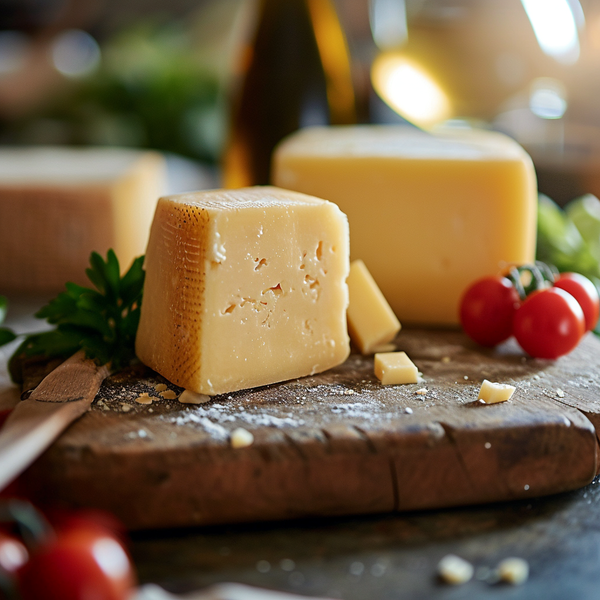
Cheese
Cheese is a versatile and widely used ingredient in cooking, celebrated for its vast array of flavors, textures, and melting properties. From soft and fresh to hard and aged, the type of cheese chosen can significantly influence the taste, texture, and overall outcome of a dish. Here's how cheese is used in various culinary applications:
Melting in Dishes:
Pizzas and Lasagnas: Cheeses like mozzarella are prized for their excellent melting qualities, making them a top choice for pizzas, lasagnas, and other baked pasta dishes.
Fondue and Cheese Sauces: Gruyère, Emmental, and cheddar are often used in fondues and cheese sauces for their smooth melting properties and flavor.
Grating and Sprinkling:
Pasta and Risotto: Hard, aged cheeses such as Parmesan, Pecorino Romano, and Asiago are frequently grated over pasta dishes, risottos, and soups to add a savory umami punch.
Salads: Finely grated or shaved cheese can add a rich flavor to salads.
Baking:
Cheesecakes and Pastries: Soft cheeses like cream cheese, ricotta, and mascarpone are key ingredients in desserts like cheesecakes, cannolis, and other creamy pastries.
Quiches and Savory Pies: A variety of cheeses can be used in quiches, savory pies, and tarts to add flavor and richness.
Stuffing and Filling:
Stuffed Meats and Vegetables: Cheeses such as feta, goat cheese, and blue cheese are used to stuff meats (like chicken breasts) and vegetables (such as bell peppers and mushrooms), adding moisture and flavor.
Spreading:
Sandwiches and Crackers: Soft, spreadable cheeses like Brie, Camembert, and cream cheese are used in sandwiches and as spreads for crackers and bread.
Topping and Crusting:
Au Gratin Dishes and Casseroles: Hard cheeses are often used as a topping for gratin dishes and casseroles, where they form a golden, crispy crust when baked.
Salads: Crumbled cheeses like feta, blue cheese, and goat cheese add a creamy or tangy touch to salads.
Browning and Broiling:
Grilled Cheese and Bruschetta: Many cheeses brown beautifully under a broiler or on a griddle, making them perfect for dishes like grilled cheese sandwiches and bruschetta.
Cold Dishes:
Cheese Boards and Appetizers: A selection of cheeses can be served as part of a cheese board, accompanied by fruits, nuts, and charcuterie, or used in cold appetizers.
Sauces and Dips:
Cheese Dips and Spreads: Melted cheeses are combined with ingredients like beer, wine, or spices to create warm dips and spreads for bread and vegetables.
Flavoring and Seasoning:
Ricotta and Cottage Cheese: These fresh cheeses are mixed into fillings for pasta like ravioli and lasagna or added to pancake and muffin batters for moisture and mild flavor.
When using cheese in cooking, it's essential to consider the specific characteristics of the cheese—such as flavor intensity, moisture content, and how it reacts to heat—to ensure it complements the dish. The wide range of available cheeses, from mild to strong, soft to hard, allows for immense creativity in the kitchen, enhancing dishes with their unique flavors and textures.
Nutritional Information
carbohydrates
4.71 g
fats
26.91 g
protein
22.21 g
calories
350